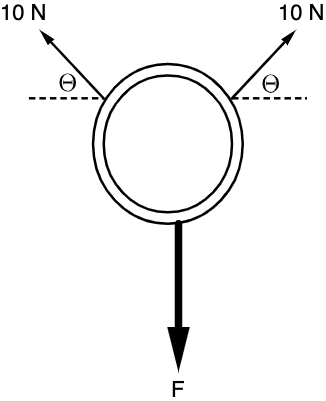Question:
If an object is moving, is it possible for the net force acting on it to be zero?
Answer
Yes, it is possible.
| Explanation | Example |
|---|---|
| When an object moves with constant velocity (including zero acceleration), the net force acting on it is zero. This is in accordance with Newton’s First Law of Motion, which states that an object in motion will remain in motion at a constant velocity unless acted upon by a net external force. | A 10 kg object sliding on a frictionless surface at a constant speed. |
Question:
If the acceleration of an object is zero, are no forces acting on it?
Answer:
No, it’s not necessarily true that no forces are acting on it.
| Explanation | Example |
|---|---|
| Zero acceleration means that the net force is zero, but it does not imply that no forces are acting on the object. It could be that multiple forces are acting on it, but they are balanced, resulting in no net force and thus no acceleration. | A 10 kg object at rest on a horizontal surface with gravitational force downward balanced by the normal force upward. |
Question:
Only one force acts on an object. Can the object have zero acceleration?
Answer:
No, if only one force acts on an object, the object cannot have zero acceleration.
| Explanation | Example |
|---|---|
| If a single unbalanced force acts on an object, it will cause the object to accelerate in the direction of the force, in accordance with Newton’s Second Law of Motion. | A 10 kg object in free fall under the influence of gravity alone. |
Question:
Only one force acts on an object. Can it have zero velocity?
Answer:
Yes, it can have zero velocity at a specific moment.
| Explanation | Example |
|---|---|
| An object can have zero velocity at a particular instant, especially at the turning point in its motion, even if a single force is acting on it. However, it will not remain at zero velocity if the force continues to act. | A 10 kg object thrown vertically upward will have zero velocity at the highest point of its trajectory, before starting to fall back down. |
Each of these examples demonstrates different aspects of Newton’s Laws of Motion and the relationship between forces, velocity, and acceleration.
Phy can also check your working. Just snap a picture!

A ring is pulled on by three forces. If the ring is not moving, how big is the force F?
Which of the following statements about the acceleration due to gravity is TRUE?
A skydiver reaches a terminal velocity of 55.0 m/s. At terminal velocity, the skydiver no longer accelerates. The mass of the skydiver and her equipment is 87.0 kg. What is the force of friction acting on her?
Friction provides the force needed for a car to travel around a flat, circular race track. Answer the following:

A crate rests on a horizontal surface and a woman pulls on it with a 10-N force. No matter what the orientation of the force, the crate does not move. From least to greatest, rank the normal force on the crate.
By continuing you (1) agree to our Terms of Sale and Terms of Use and (2) consent to sharing your IP and browser information used by this site’s security protocols as outlined in our Privacy Policy.
| Kinematics | Forces |
|---|---|
| \Delta x = v_i t + \frac{1}{2} at^2 | F = ma |
| v = v_i + at | F_g = \frac{G m_1m_2}{r^2} |
| a = \frac{\Delta v}{\Delta t} | f = \mu N |
| R = \frac{v_i^2 \sin(2\theta)}{g} |
| Circular Motion | Energy |
|---|---|
| F_c = \frac{mv^2}{r} | KE = \frac{1}{2} mv^2 |
| a_c = \frac{v^2}{r} | PE = mgh |
| KE_i + PE_i = KE_f + PE_f |
| Momentum | Torque and Rotations |
|---|---|
| p = m v | \tau = r \cdot F \cdot \sin(\theta) |
| J = \Delta p | I = \sum mr^2 |
| p_i = p_f | L = I \cdot \omega |
| Simple Harmonic Motion |
|---|
| F = -k x |
| T = 2\pi \sqrt{\frac{l}{g}} |
| T = 2\pi \sqrt{\frac{m}{k}} |
| Constant | Description |
|---|---|
| g | Acceleration due to gravity, typically 9.8 , \text{m/s}^2 on Earth’s surface |
| G | Universal Gravitational Constant, 6.674 \times 10^{-11} , \text{N} \cdot \text{m}^2/\text{kg}^2 |
| \mu_k and \mu_s | Coefficients of kinetic (\mu_k) and static (\mu_s) friction, dimensionless. Static friction (\mu_s) is usually greater than kinetic friction (\mu_k) as it resists the start of motion. |
| k | Spring constant, in \text{N/m} |
| M_E = 5.972 \times 10^{24} , \text{kg} | Mass of the Earth |
| M_M = 7.348 \times 10^{22} , \text{kg} | Mass of the Moon |
| M_M = 1.989 \times 10^{30} , \text{kg} | Mass of the Sun |
| Variable | SI Unit |
|---|---|
| s (Displacement) | \text{meters (m)} |
| v (Velocity) | \text{meters per second (m/s)} |
| a (Acceleration) | \text{meters per second squared (m/s}^2\text{)} |
| t (Time) | \text{seconds (s)} |
| m (Mass) | \text{kilograms (kg)} |
| Variable | Derived SI Unit |
|---|---|
| F (Force) | \text{newtons (N)} |
| E, PE, KE (Energy, Potential Energy, Kinetic Energy) | \text{joules (J)} |
| P (Power) | \text{watts (W)} |
| p (Momentum) | \text{kilogram meters per second (kgm/s)} |
| \omega (Angular Velocity) | \text{radians per second (rad/s)} |
| \tau (Torque) | \text{newton meters (Nm)} |
| I (Moment of Inertia) | \text{kilogram meter squared (kgm}^2\text{)} |
| f (Frequency) | \text{hertz (Hz)} |
General Metric Conversion Chart
Example of using unit analysis: Convert 5 kilometers to millimeters.
Start with the given measurement: \text{5 km}
Use the conversion factors for kilometers to meters and meters to millimeters: \text{5 km} \times \frac{10^3 \, \text{m}}{1 \, \text{km}} \times \frac{10^3 \, \text{mm}}{1 \, \text{m}}
Perform the multiplication: \text{5 km} \times \frac{10^3 \, \text{m}}{1 \, \text{km}} \times \frac{10^3 \, \text{mm}}{1 \, \text{m}} = 5 \times 10^3 \times 10^3 \, \text{mm}
Simplify to get the final answer: \boxed{5 \times 10^6 \, \text{mm}}
Prefix | Symbol | Power of Ten | Equivalent |
|---|---|---|---|
Pico- | p | 10^{-12} | 0.000000000001 |
Nano- | n | 10^{-9} | 0.000000001 |
Micro- | µ | 10^{-6} | 0.000001 |
Milli- | m | 10^{-3} | 0.001 |
Centi- | c | 10^{-2} | 0.01 |
Deci- | d | 10^{-1} | 0.1 |
(Base unit) | – | 10^{0} | 1 |
Deca- or Deka- | da | 10^{1} | 10 |
Hecto- | h | 10^{2} | 100 |
Kilo- | k | 10^{3} | 1,000 |
Mega- | M | 10^{6} | 1,000,000 |
Giga- | G | 10^{9} | 1,000,000,000 |
Tera- | T | 10^{12} | 1,000,000,000,000 |
The most advanced version of Phy. Currently 50% off, for early supporters.
per month
Billed Monthly. Cancel Anytime.
Trial –> Phy Pro
A quick explanation
UBQ credits are specifically used to grade your FRQs and GQs.
You can still view questions and see answers without credits.
Submitting an answer counts as 1 attempt.
Seeing answer or explanation counts as a failed attempt.
Lastly, check your average score, across every attempt, in the top left.
MCQs are 1 point each. GQs are 1 point. FRQs will state points for each part.
Phy can give partial credit for GQs & FRQs.
Phy sees everything.
It customizes responses, explanations, and feedback based on what you struggle with. Try your best on every question!
Understand you mistakes quicker.

For GQs and FRQs, Phy provides brief feedback as to how you can improve your answer.
Aim to increase your understadning and average score with every attempt!
10 Free Credits To Get You Started
*Phy Pro members get unlimited credits

By continuing you agree to nerd-notes.com Terms of Service, Privacy Policy, and our usage of user data.